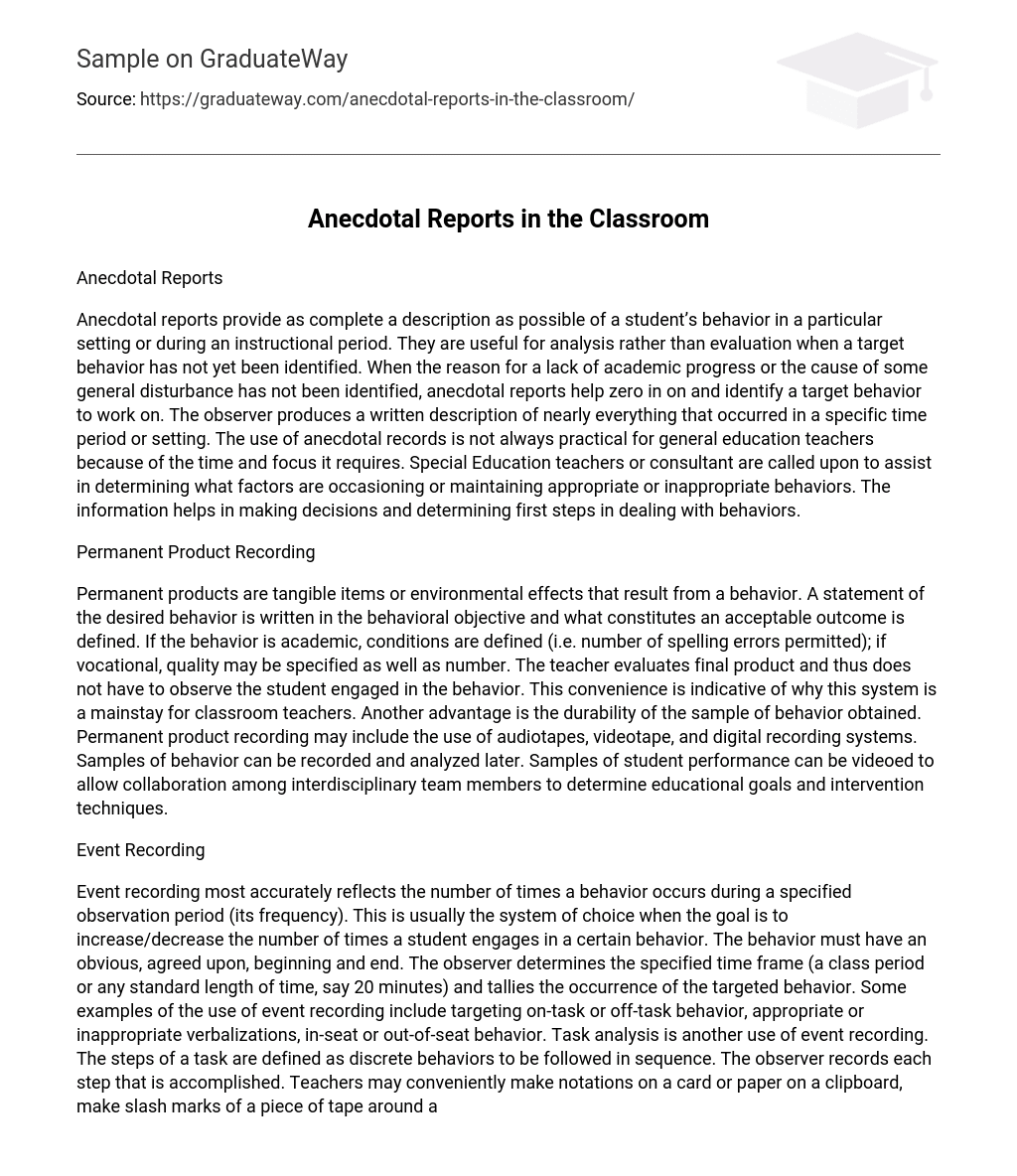Reports based on personal stories or experiences.
Anecdotal reports are useful for analyzing a student’s behavior in a specific setting or during a certain instructional period. They can help identify a target behavior when its cause is not yet known. By providing a written description of everything that happened during a certain time period or setting, anecdotal reports can help pinpoint and address specific issues. However, using anecdotal records may not always be feasible for general education teachers due to the time and focus required. In such cases, Special Education teachers or consultants can be called upon to assist in identifying the factors behind appropriate or inappropriate behaviors. The information from these reports is valuable in making decisions and determining the initial steps to address behaviors.
Permanent Product Recording
Permanent products refer to physical items or environmental effects that are the result of a behavior. A behavioral objective defines the desired behavior and specifies what is considered an acceptable outcome. For academic behaviors, conditions such as the allowed number of spelling errors may be included, while vocational behaviors may specify both quality and quantity. The teacher is able to evaluate the final product without directly observing the behavior, making this system convenient for classroom teachers. Additionally, permanent product recording allows for the collection of durable samples of behavior, which can be analyzed later. This recording method can involve audiotapes, videotapes, or digital recording systems. By videoing samples of student performance, interdisciplinary team members can collaborate to determine educational goals and intervention techniques.
Event Recording
Event recording is a valuable method for accurately measuring the frequency of a behavior during a specific observation period. It is commonly used when the goal is to increase or decrease the occurrence of a particular behavior. The behavior must have a clear beginning and end that is agreed upon.
The observer selects a designated time frame, such as a class period or 20 minutes, and keeps track of how often the targeted behavior happens. Examples of behaviors that can be measured using event recording include on-task or off-task behavior, appropriate or inappropriate verbalizations, and in-seat or out-of-seat behavior.
Task analysis is another application of event recording, where the steps of a task are broken down into discrete behaviors to be followed in a specific sequence. Each accomplished step is recorded by the observer.
Teachers have various methods for documenting these observations, such as making notes on a card or clipboard, using slash marks on wrist tape, or transferring paper clips between pockets. Once the lesson is complete, the tallied information is transferred to a data sheet.
Controlled Presentations are variations of event recording where the teacher controls the number of well-defined opportunities (trials) given to the student for performing specific tasks. Each trial consists of an antecedent stimulus, response, and consequent stimulus. This method allows tracking progress in producing correct responses for teachers.
Time Sampling
Time sampling is a technique used to estimate the frequency of behavior over a longer duration, typically hours instead of minutes. It is especially useful for behaviors that occur frequently or last for extended periods, such as paying attention or standing up from a seat. These types of behaviors can be difficult to track using event-based methods. In this approach, the observer divides a chosen time period into equal intervals, usually minutes. At the end of each interval, the observer records whether the target behavior is currently occurring – with one notation indicating yes or no – regardless of how many times it happened within that timeframe. By spacing out the observations in minutes rather than seconds, this system becomes more feasible for teaching and data collection simultaneously. The resulting data is presented as a percentage based on how many intervals included the observed behavior.
Recording the duration
Duration Recording is utilized when the main focus is the length of time a student partakes in a specific behavior. It is crucial to explicitly establish the starting and ending points of said behavior. Average duration is employed for behaviors the student regularly or routinely engages in (such as leaving the classroom to use the restroom). Total duration recording gauges the amount of time a student spends engaging in a behavior within a specified time frame (for instance, participating in appropriate play for fifteen minutes). While a second hand can be utilized, the use of a stopwatch is advised for convenience and precision.
Latency Recording
Latency Recording focuses on measuring the time it takes for a student to initiate a behavior in response to a request. This tool is helpful for training students to improve transition times or promptly begin their academic work following an assignment.





